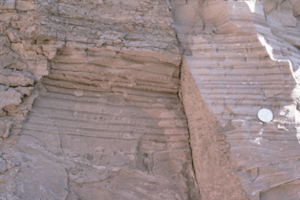Varve facts for kids
A varve is a special kind of layer found in sediment or sedimentary rock. Think of it like a tree ring, but instead of showing a tree's age, it shows a year's worth of deposits in water. These layers help scientists learn about Earth's past.
Contents
What Are Varves?
Varves are annual layers of sediment. This means each layer represents one year of material settling in water. They are often found in places where glaciers used to be, like old glacial lakes.
Where Does the Word Come From?
The word 'varve' comes from the Swedish word varv. This word can mean 'revolution', 'in layers', or 'circle'.
The idea of 'varved clay' first appeared on a map from the Geological Survey of Sweden in 1862. Later, in 1910, a Swedish geologist named Gerard De Geer gave 'varve' its official meaning. He said a varve is the entire annual layer of sediment.
Why Are Varves Important?
Varves are very useful for studying past climate change. They are like a natural calendar, recording changes in the environment year by year. By looking at varves, scientists can understand how climates changed long ago. They are some of the smallest details we can see in the layers of Earth's history, called stratigraphy.
How Do Varves Form?
An annual varve layer is often easy to see. This is because the particles that settle in the spring are different from those that settle later in the year.
- In spring, when snow and ice melt, a lot of water flows into lakes. This water carries larger, coarser particles like sand and silt. These settle quickly, forming a thicker, lighter-colored layer.
- As the year goes on, the water flow slows down. Finer particles, like clay, slowly settle out. This forms a thinner, darker-colored layer on top of the coarser one.
So, each year creates a pair of layers: one coarse and one fine. This pair is one varve.
Where Do Varves Form?
Varves usually form only in fresh or slightly salty (brackish) water. They don't form well in normal sea water.
This is because salty water makes clay particles clump together. When clay clumps, it settles quickly all year round. This makes it very hard to see the individual annual layers. In fresh water, clay particles stay separate longer, allowing them to settle slowly and form distinct layers.
See also
 In Spanish: Varva para niños
In Spanish: Varva para niños


